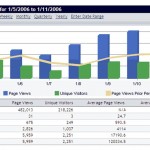In yesterdays post we discussed Online Art Galleries and Slide Registries. Today we will look at Template Art Portfolios.
Part 3 – Template Art Portfolio Services
These services allow you to create an online portfolio of your work by choosing a website design based on an existing template library. Often these are hosted sites which allow the artist to add and edit their own work. Some good examples are qfolio and FolioLink.
The process works like this: You choose a template style from the vendor’s library of templates and upload photos of your work together with your bio, artist’s statement, resume, etc. Depending on the service provider, either you or they then put your images and text into the template and …. Voila!….. You have your website up and running.
The advantages of template-based portfolios are straightforward. The process is fast; you know exactly what you will get and how much it will cost; and the process of adding to or changing your site is fairly simple. In short, you have control. They are particularly good for commercial artists because its quite possible to have a very large body of your work online at a reasonable cost.
The disadvantages? The most basic one is that the website might never really reflect and communicate you as an artist because it was not built from the ground up to showcase you and your work. Secondly, it is important to check out the fee structure before you go in. With some template services you might be paying more than $500 for a simple site by the time you add up all the fees. It’s also important to look at the monthly hosting fees, which can be quite high.
Our advice on Template Portfolios: They work really well for some artists – particularly if your focus is on the commercial market – illustration, design, etc. Just be aware of the cost and ask yourself if the site is really showcasing you the way you would like – If you’re primarily focused on Galleries and Collectors you might want to consider a more customized solution.



